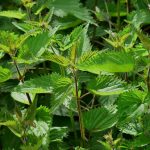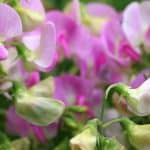Last updated on February 27th, 2022
Our site is reader supported, this means we may earn a small commission from Amazon and other affiliates when you buy through links on our site.
Apple trees should be pruned yearly, usually between November and early March when it has dropped all of their leaves for the winter. You want to remove around 10-20% of the overall canopy evenly, and this should only consist of around 10-20 cuts. Remember that around 10-20% of the canopy is between 10 and 20 cuts in total. This idea is to remove some of the previous year’s growth but leave plenty of growth that is 1-5 years old because these stems produce the best fruit.
The same pruning process can also be done with pear trees.
Knowing what time of year to prune apple trees and how to prune apple trees can appear confusing because there are a few variations, and these are based on the age of your tree. Experts agree that there are certain principles that you must abide by when you are pruning fruit trees. These principles refer to training the trees early on, how to pick the correct branches for pruning, how to thin out broken or crowding branches, and how to keep your tree at a desirable height.
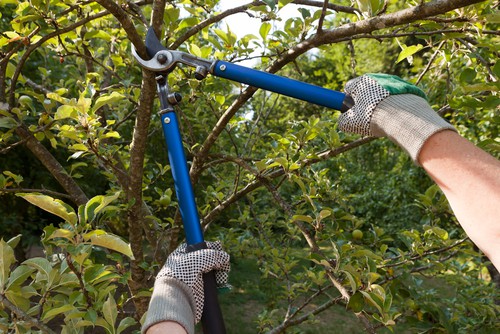
Easy pruning tips to follow for the effective pruning of bush fruit trees, which is what most home gardens have
- First things first, you don’t want to trim too much off the tree and an absolute maximum of 20% should be removed from the canopy. You want to remove some of the older wood each year and leave the newer wood that is 1-5 years old and produces the best fruit. If you think you have pruned off a fair bit, just stop and prune again the following year. The idea is to prune all of the main stems back slightly to encourage new growth around the whole tree. You will be pruning good sized branches and will likely need loppers because this is not about removing little fiddly branches.
- Ideally, you also need the centre of the tree to be fairly open to provides good air circulation because this will help to prevent diseases as well as let light reach the fruit so they ripen faster.
- All cuts should be staggered throughout the tree so that the new growth is all nice and even and not all confined to one part of the tree. If you prune just the top of the trees for example, which is often a common mistake, you will encourage lots of new shoots that won’t produce any fruit and you will end up needing to prune again. Start at one side and work right around the tree removing a small section of old wood so that it’s even all the way round.
Training Orchard Style Apple Trees
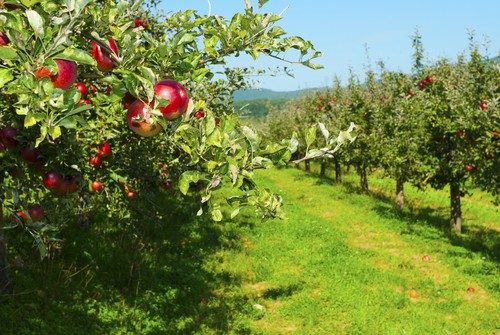
The training and selection of a framework that you do for your tree should be done within the first few years of growth. If you do this properly it will influence the strength and the longevity of your apple tree. There are several systems that you can use to properly train your tree but the best system is considered to be the modified leader system. This is a system whereby you allow one main limb, the leader, to develop vertically for the first 5 years or so until it is strong and has developed desirable scaffolds in a lateral direction. Once you have the lateral scaffolds, that central leader should be cut back to about 2.5 meters in order to create a wide-angled limb.
This subsequent limb, if possible, should be located on the windward side of your tree in order to help the tree maintain a proper shape. It is equally important that the lowest scaffold branches be on the windward side. For the first few years of life, you want that leader branch or one main limb to be stronger in diameter and larger compared to the scaffold limbs. Doing so will help to maintain strong crotches and it will prevent the scaffolds from trying to fight for leadership. You can occasionally snip back the tips of your scaffold branches approximately 1/2 metre to keep them below the height of the leading branch. Once you have harvested your first or second crops these limbs will start to bend enough that you won’t need to do this.
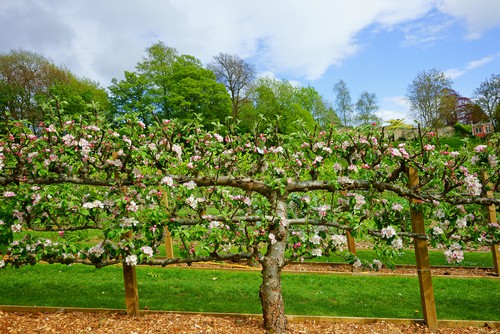
Delayed Heading
You might not want to follow standard procedures and train your young tree, and if this is the case you can use delayed heading tactics. This is a practice that is successfully used by many who have orchards and it is the practice of pruning back the top of your apple tree to the strongest bud which will then become your central leader and that is a process that starts once the trees are planted. This means cutting your whip back 100cm or so, but not to the typical height desired. The buds below this cut will grow the branches that are also known as the lateral limbs.
Scaffold branches that develop near this cut will typically have narrow-angled crotches. Limbs that are below this will have the stronger, wide-angled crotches. After about two months when your top shoots have increased in size you can trim back the central leader to the height that you desire. This will be the point below which other crotches develop. As a result, the remaining top shoot will take its role as the leader for any future growth.
In certain situations, bud suppression will help cultivate a good tree structure for your apple tree. If you choose to do it, do it twice per year once in June and then again in July, and do it for two years in a row.
Scaffold Limbs
You should choose your scaffolds based on where they originated. You want scaffolds that originated on various sides of your main leader with the lowest limb being located on the windward side. Permanent scaffold limbs should never be more than 300cm together at their base because they will develop side branches and you don’t want them to run into one another. Preserve the side branches with wide angles and thin out those that are crowding the trunk. There are usually four permanent scaffold limbs that you will get out of your main trunk but there could be up to eight depending on how tall your tree is.
Strong, Wide-angle Crotches
The limbs you choose for scaffolds need to form a strong, wide-angle crotch between 60° and 90°. If you only have narrow-angled crotches on a younger apple tree, remove all of them so that new limbs develop. This will cause some delay short-term but long-term it will save you a lot of trouble when trying to shape and train your tree.
Crowding and Crossing Branches
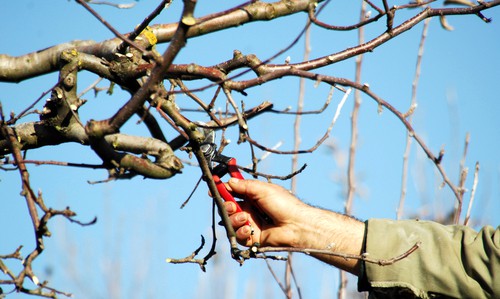
You should not remove branches on younger trees unless they are interfering and rubbing against other branches. If they are left unpruned it can cause diseases. So, if there are other branches that are rubbing against the permanent branches they can be removed. This will help with air circulation as well as better growth. Opening up your tree by removing the weaker, crowding branches will also help you control diseases and insects. Crowded branches should be removed, especially if they are growing downwards rather than upwards. If they are already growing downwards, the weight of subsequent fruit will pull them down even more.
Thin Wood Pruning
It is economical to prune thin wood so that you can get higher production of apples that are of better quality. The thin wood is located on the outer reaches of your tree and towards the centre of your tree. You will need a ladder to reach all of the thin wood and remove it properly.
| 3 to 5 years old | Younger trees should be trained but pruning should be limited to simply removing any crowding branches and helping the permanent scaffolds. |
| 6 to 10 years old | Trees at this age will grow very quickly and by now the scaffold and shape should already be established. These limbs will grow upwards rather than out so you can bend them down with pruning. If you prune too much at this age it will delay the fruiting of your tree. |
| 10 years or older | Trees that fall into this age group are in the prime of fruiting. Their limbs will start to bend because of the weight of the apples and you should generally remove any thin wood, broken branches or crowded branches. You need to also maintain proper size and shape without accidentally stimulating additional growth. Never remove all branches from the top of your tree so that the centre is left exposed. Trees that fall under this age group should be pruned as much as possible on the outside and the inside. Limbs that are touching the ground or have no fruit need to be removed. Limbs that are crowding should be removed as well. |
Equipment
The equipment that you need for pruning your trees should consist of at least two hand tools, such as a pruning saw and a good pair of loppers. With younger trees, you might be able to just use secateurs. It is important to have a thin ladder so that you can reach the wood on older trees, we recommend using tripod ladders because they allow you to get closer to the tree and are also great for fruit picking.
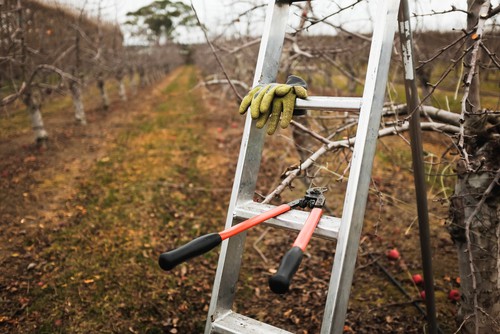
There are of course other ways to make most of the content you have chopped away. The larger limbs (that are at least 60cm) can be split with an axe and then stored later for firewood. Smaller wood can be shredded and again used as mulch to suppress weeds or as kindling.

